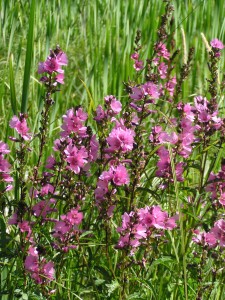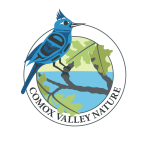In late July a concerned individual contacted the Comox Valley Naturalists Society to report that purple loosestrife was running rampant in the Courtenay estuary! As the Wetland Restoration crew working on behalf of the CVNS had just finished working in the estuary I was surprised by the report. They had found and removed only a small number of the invasive purple loosestrife plants. Nevertheless I went down to check out this report. What I found was not purple loosestrife but masses of our beautiful native Henderson’s checkermallow (Sidalcea hendersonii) which is sometimes called the marsh hollyhock. From a distance it might well be mistaken for the nefarious purple loosestrife (Lythrum salicaria).
Checkermallow is readily seen growing along the Dyke road in the Courtenay River estuary. In full bloom (late July to August) it puts on a spectacular show of pink flowers. It is tolerant of the salt water and requires humus soil. The estuary provides ideal habitat where the plant can reach more than a meter in height.
We are indeed lucky to have such a beautiful plant growing in our estuary. The Checkermallow grows only in the Pacific Northwest and we are at the northern fringe of its range. It is in fact a Blue listed species, or a species of special concern in BC. This means there are relatively few populations of the plant in our province and those that exist are vulnerable to disturbance.
This beautiful plant is just one of the reasons our estuary is special and needs protection. Much of the work of the CVNS Wetland Restoration project is focused on removing invasive plants such as purple loosestrife and yellowflag iris that can overtake habitat for our native plants like the Henderson’s checkermallow. Although the initial report was mistaken it is great to see that the public is concerned about what is growing in our estuary and are keeping an eye out for non-native invaders.
The Wetland Restoration Project is managed by the Comox Valley Naturalists. Much of the work is being done by contractor Lynda Fyfe of Juniper Environmental Services and with the assistance of volunteers from the Naturalists Society. This important project is made possible through the generous grants from the Comox Valley Regional District, City of Courtenay, Ducks Unlimited Canada and BC Nature. We are truly grateful to our funders who have supported this project through the years.
[mappress mapid=”2″]
The Comox Valley Naturalists Society is an affiliated club of BC Nature, our parent provincial organization.


